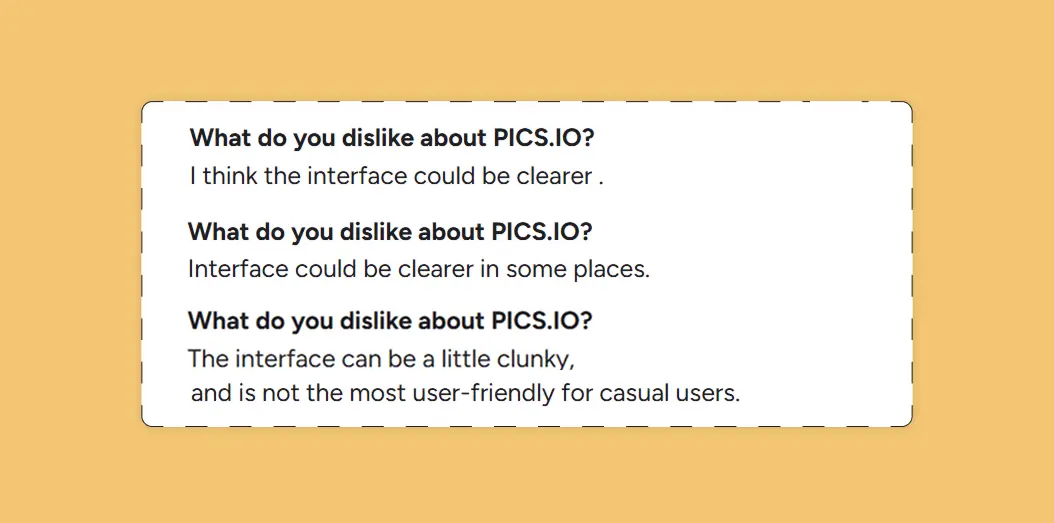The Best Pics.io Alternatives for Digital Asset management(2025 review, pricing & open demos)

Pics.io is a veteran tool for teams that need more organization than Dropbox or Google Drive. It's has good basic features, and is relatively simple to use. That said, it’s not always the best fit.
If you're evaluating Pics.io, here are a few alternatives you might want to consider:
✓ Tagbox.io
✓ Brandfolder
✓ Bynder
✓ Filecamp
✓ Playbook
In this post, we’ll look at what Pics.io does well, where it falls short, and what alternatives can offer.
Pics.io - overview
Pics.io positions itself as a versatile DAM for creative teams and eCommerce companies. It comes with standard features like collections, versioning, and integrations with tools such as Google Drive, Slack, and Shopify.
It stands out for its integrations and versioning features, as well as a Shopify app that extends its use into eCommerce. However, pricing can escalate quickly with add‑ons, the per‑user model is limiting for larger teams, and many users find the AI less smooth compared to alternatives.

Why You Need A Pics.io Alternative
❌ Pricing uncertainty
what looks like as $225/mo can quickly turn into $800+ with more users or basic AI features. Adding just 10 users can increase the cost by $200/mo, and a feature like visual search, that should be standard, spikes the cost by no less than $300/mo.
❌ Clunky AI
Auto-tagging and search exist, but many reviewers note that they feel inconsistent and less intuitive than competitors. Tags can be overly generic, search sometimes misses relevant results, and the interface doesn’t make it easy to refine or filter. Facial recognition is also lacking, taking too long and not applied automatically across assets. For teams that rely on precise, reliable AI to surface the right assets quickly, this can lead to frustration and extra manual work. In short - great intentions, medium execution.
❌ Ease of use
lightweight DAMs that are designed for small-to-medium teams with low resources should be simple to operate. Pics.io, however, often requires training to get started. They even include training sessions with each plan, which is helpful, yet the very need for structured onboarding suggests the interface isn’t as intuitive as competitors. For teams expecting a plug‑and‑play tool, this can create friction.
Tagbox.io - a DAM with a touch of magic
Tagbox.io was built to give teams a simpler, more flexible DAM without the enterprise bloat. Pricing is straightforward at $400/month for unlimited members, so you don’t have to think twice about who can access the system. The AI is tuned for real-world use: semantic search, text-in-image, face recognition, and even custom AI tagging trained on your own product catalog. Sharing is just as easy, with collection automations, open gallery links, and precise permissions.
AI that just works
every customer gets advanced semantic search, text-in-image, and face recognition without needing costly add-ons - even the free plan includes these, so you can comfortably try before you buy. This ensures even smaller teams benefit from powerful AI from day one, instead of having to justify an upsell.
Better support for video
Tagbox includes a second-by-second video timeline, allowing users to jump directly to the right scene. This is especially valuable for sports, events, or long-form content where finding a specific moment quickly saves major effort. For teams producing social media, the ability to instantly pinpoint clips is critical. Combined with custom AI tagging, Tagbox can even identify specific products within video, making it far easier to repurpose content across campaigns and platforms.
Simple, predictable pricing
Tagbox’s pricing is transparent and available on its website. It has 4 different plans:
Starter Plan ($250/month): 5,000 items and 5 users.
Basic Plan ($400/month): 10,000 items and unlimited users.
Pro Plan ($600/month): from 25,000 items with unlimited users, and many advanced features.
Enterprise Plan: (custom pricing) includes platform customizations, dedicated integrations, and more.
Feature by feature comparison
up and running in a week
Setting up a Digital Asset Management platformcan take months.
At Tagbox, we understand that a productivity tool is supposed to, well, help productivity, which is why our data migration team would love to help get organized within just one week of signing up.

Frequently
Asked
Questions
Who should use Pics.io?
Larger marketing or eCommerce teams that want integrations and flexible hosting options, and don’t mind managing per-seat licenses.
How much does Pics.io cost?
Pricing starts at $225/month, but costs can climb quickly depending on how you use it. Adding extra users, enabling AI search, or turning on certain advanced features can more than double the price. Because of this, it’s important to carefully check which features you actually need and how many people will be using the system. For teams that plan to scale broadly or share access externally, the pricing model can become unpredictable.
What are the top alternatives to Pics.io?
The top alternatives to Pics.io include Tagbox.io, Bynder, Air.inc, Filecamp, and Canto.
Get your assets organized
Try Tagbox for free





.png)

